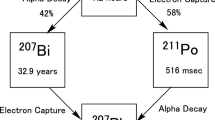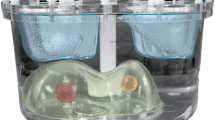Abstract
Objective
To examine the impact of acquisition time on Lutetium-177 (177Lu) single-photon emission computed tomography (SPECT) images using Monte Carlo simulation.
Methods
A gamma camera simulation based on the Monte Carlo method was performed to produce SPECT images. The phantom was modeled on a NEMA IEC BODY phantom including six spheres as tumors. After the administration of 7.4 GBq of 177Lu, radioactivity concentrations of the tumor/liver at 6, 24, and 72 h after administration were set to 1.85/0.201, 2.12/0.156, and 1.95/0.117 MBq/mL, respectively. In addition, the radioactivity concentrations of the tumor at 72 h after administration varied by 1/2, 1/4, and 1/8 when comparison was made. Acquisition times examined were 1.2, 1.5, 2, 3, 6, and 12 min. To assess the impact of collimators, SPECT data acquired at 72 h after the administration using six collimators of low-energy high-resolution (LEHR), extended low-energy general-purpose (ELEGP), medium-energy, and general-purpose (MEGP-1, MEGP-2, and MEGP-3) and high-energy general-purpose (HEGP) were examined. After prefiltering using a Butterworth filter, projection images were reconstructed using ordered subset expectation maximization. The detected photons were classified into direct rays, scattered rays, penetrating rays, and characteristic X-rays from lead. The image quality was evaluated through visual assessment, and physical assessment of contrast recovery coefficient (CRC) and contrast-to-noise ratio (CNR). In this study, the CNR threshold for detectability was assumed to be 5.0.
Results
To compare collimators, the highest sensitivity was observed with ELEGP, followed by LEHR and MEGP-1. The highest ratio of direct ray was also observed in ELEGP followed by MEGP-1. In comparison of the radioactivity concentration ratios of tumor/liver, CRC and CNR were significantly decreased with smaller radioactivity concentration ratios. This effect was greater with larger spheres. According to the visual assessment, the acquisition time of 6, 6, and 3 min or longer was required using ELEGP collimator at 6, 24, and 72 h after administration, respectively. Physical assessment based on CNR and CRC also suggested that 6, 6, and 3 min or longer acquisition time was necessary at 6, 24, and 72 h after administration.
Conclusion
177Lu-SPECT images generated via the Monte Carlo simulation suggested that the recommended acquisition time was 6 min or longer at 6 and 24 h and 3 min or longer at 72 h after administration.









Similar content being viewed by others
References
Kellett MA. 177Lu: DDEP Assessment of the decay scheme for an emerging radiopharmaceutical. Appl Radiat Isot. 2016;109:129–32.
Kossert K, Näle OJ, Ott O, Dersch R. Activity determination and nuclear decay data of 177Lu. Appl Radiat Isot. 2012;70:2215–21.
Sanders JC, Kuwert T, Hornegger J, Ritt P. Quantitative SPECT/CT imaging of 177Lu with in vivo validation in patients undergoing peptide receptor radionuclide therapy. Mol Imaging Biol. 2015;17:585–93.
Gleisner KS, Brolin G, Sundlöv A, Mjekiqi E, Östlund K, Tennvall J, et al. Long-Term retention of 177Lu/177mLu-DOTATATE in patients investigated by g-spectrometry and g-camera imaging. J Nucl Med. 2016;56:976–84.
Rudisile S, Gosewisch A, Wenter V, Unterrainer M, Böning G, Gildehaus FJ, et al. Salvage PRRT with 177Lu-DOTA-octreotate in extensively pretreated patients with metastatic neuroendocrine tumor (NET): dosimetry, toxicity, efficacy, and survival. BMC Cancer. 2019;19:788. https://doi.org/10.1186/s12885-019-6000-y.
Satapathy S, Mittal B. 177Lu-DOTATATE peptide receptor radionuclide therapy versus Everolimus in advanced pancreatic neuroendocrine tumors: a systematic review and meta-analysis. Nucl Med Commun. 2019;40(12):1195–203.
Garkavij M, Nickel M, Gleisner KS, Ljungberg M, Ohlsson T, Wingårdh K, et al. 177Lu-[DOTA0, Tyr3] octreotate therapy in patients with disseminated neuroendocrine tumors: analysis of dosimetry with impact on future therapeutic strategy. Cancer. 2010;116:1084–92.
Maaß C, Sachs JP, Hardiansyah D, Mottaghy FM, Kletting P, Glatting G. Dependence of treatment planning accuracy in peptide receptor radionuclide therapy on the sampling schedule. Eur J Nucl Med Mol Imaging. 2016;6:30. https://doi.org/10.1186/s13550-016-0185-8.
Melis M, Swart JD, Visser MD, Berndsen SC, Koelewijin S, Valkema R, et al. Dynamic and static small-animal spect in rats for monitoring renal function after 177Lu-labeled Tyr3-octreotate radionuclide therapy. J Nucl Med. 2010;51:1962–68.
Baum RP, Kulkarni HR, Schuchardt C, Singh A, Wirtz M, Wiessalla S, et al. Lutetium-177 PSMA radioligand therapy of metastatic castration-resistant prostate cancer: safety and efficacy. J Nucl Med. 2016. https://doi.org/10.2967/jnumed.115.168443.
Khawar A, Eppard E, Roesch F, Ahmadzadehfar H, Kürpig S, Meisenheimer M, et al. Biodistribution and post-therapy dosimetric analysis of [177Lu]Lu-DOTAZOL in patients with osteoblastic metastases: first results. EJNMMI Res. 2019;9:102. https://doi.org/10.1186/s13550-019-0566-x.
Chicheportiche A, Haim SB, Glasberg SG, Oleinikov K, Meirovitz A, et al. Dosimetry after peptide receptor radionuclide therapy: impact of reduced number of post-treatment studies on absorbed dose calculation and on patient management. Eur J Nucl Med Mol Imaging. 2020;7:5. https://doi.org/10.1186/s40658-020-0273-8.
Vallabhajosula S, Goldsmith SJ, Hamacher KA, Kostakoglu L, Konishi S, Gross DJ, et al. Prediction of myelotoxicity based on bone marrow radiation-absorbed dose: radioimmunotherapy studies using 90Y- and 177Lu-labeled J591 antibodies specific for prostate specific membrane antigen. J Nucl Med. 2005;46:850–58.
Zaknun JJ, Bodei L, Mueller-Brand J, Pavel ME, Baum RP, Hörsch D, et al. The joint IAEA, EANM, and SNMMI practical guidance on peptide receptor radionuclide therapy (PRRNT) in neuroendocrine tumours. Eur J Nucl Med Mol Imaging. 2013;40:800–16.
Hijnen NM, Vries AD, Nicolay K, Grüll H. Dual-isotope 111In/177Lu SPECT imaging as a tool in molecular imaging tracer design. Contrast Media Mol Imaging. 2012;7:214–22.
Meyer JV, Magill S, Lee J, Umetsu S, Flavell R. Detection of Metastatic Meningioma to the Liver Using 68Ga-DOTA-Octreotate PET/CT. Clin Nucl Med. 2018;43(9):338–40.
Beauregard JM, Hofman MS, Pereira JM, Eu P, Hicks RJ. Quantitative 177Lu SPECT (QSPECT) imaging using a commercially available SPECT/CT system. Cancer Imaging. 2011;11:56–66.
Hippeläinen E, Tenhunen M, Mäenpää H, Sohlberg A. Quantitative accuracy of 177Lu SPECT reconstruction using different compensation methods: phantom and patient studies. Eur J Nucl Med Mol Imaging. 2016;6:16. https://doi.org/10.1186/s13550-016-0172-0.
Uribe CF, Esquinas PL, Tanguay J, Gonzalez M, Gaudin E, Beauregard JM, et al. Accuracy of 177Lu activity quantification in SPECT imaging: a phantom study. Eur J Nucl Med Mol Imaging. 2017;4:2. https://doi.org/10.1186/s40658-016-0170-3.
Shcherbinin S, Bilska HP, Celler A, Birkenfeld B. Quantitative SPECT/CT reconstruction for 177Lu and 177Lu/90Y targeted radionuclide therapies. Phys Med Biol. 2012;57:5733–47.
D’Arienzo M, Cazzato M, Cozzella ML, Cox M, D’Andra M, Fazio A, et al. Gamma camera calibration and validation for quantitative SPECT imaging with 177Lu. Appl Radiation and Isotopes. 2016;112:156–64.
Uehara S. The development of a Monte Carlo code simulating electron-photon showers and its assessment by various transport benchmarks. Nucl Insrum Methods Phys Res B. 1986;14:559–70.
Takahashi A, Himuro K, Yamashita Y, Komiya I, Baba S, Sasaki M. Monte Carlo simulation of PET and SPECT imaging of 90Y. Med Phys. 2015;42(4):1926–35.
Tanaka M, Uehara S, Kojima A, Matsumoto M. Monte Carlo simulation of energy spectra for 123I imaging. Phys Med Biol. 2007;52:4409–25.
Takahashi A, Miwa K, Sasaki M, Baba S. A Monte Carlo study on 223Ra imaging for unsealed radionuclide therapy. Med Phys. 2016;43(6):2965–74.
Kälkner KM, Janson ET, Nilsson S, Carlsson S, Öberg K, Westrin JE, et al. Somatostatin receptor scintigraphy in patients with carcinoid tumors: comparison between radioligand uptake and tumor markers. Cancer Res. 1995;55:5801–4.
Kim Y, Yoo C, Oh SJ, Lee SJ, Kang J, Hwang HS, et al. Tumour-to-liver ratio determined by [68Ga] Ga-DOTA-TOC PET/CT as a prognostic factor of lanreotide efficacy for patients with well-differentiated gastroenteropancreatic-neuroendocrine tumours. EJNMMI Res. 2020;10:63. https://doi.org/10.1186/s13550-020-00651-z.
Brolin G, Gustafsson J, Ljungberg M, Gleisner KS. Pharmacokinetic digital phantoms for accuracy assessment of image-based dosimetry in 177Lu-DOTATATE peptide receptor radionuclide therapy. Phys Med Biol. 2015;60:6131–49.
Taniguchi T, Akamatsu G, Kasahara Y, Mitsumoto K, Baba S, Tsutsui Y, et al. Improvement in PET/CT image quality in overweight patients with PSF and TOF. Ann Nucl Med. 2015;29:71–77.
Hashimoto N, Morita K, Tsutsui Y, Himuro K, Baba S, Sasaki M. Time-of-flight information improved the detectability of subcentimeter spheres using a clinical PET/CT scanner. J Nucl Med Technol. 2018;46(3):268–73.
Rose A. Vision: human and electronic. Optical physics and engineering. New York: Plenum Press; 1973.
Cherry SR, Sorenson JA, Phelps ME. Physics in Nuclear Medicine. 3rd ed. Pennsylvania: Elsevier; 2003.
de Nijsa R, Lagerburg V, Klausena TL, Holm S. Improving quantitative dosimetry in 177Lu-DOTATATE SPECT by energy window-based scatter corrections. Nucl Med Commun. 2014;35:522–33.
Ljungberg M, Celler A, Konijnenberg MW, Eckerman KF, Dewaraja YK, Sjögreen-Gleisner K. MIRD Pamphlet No 26: Joint EANM/MIRD guidelines for quantitative 177Lu SPECT. Applied for dosimetry of radiopharmaceutical therapy. J Nucl Med. 2016;57:151–62.
Garske U, Sandström M, Johansson S, Sundin A, Granberg D, Eriksson B, et al. Minor changes in effective half-life during fractionated 177Lu-Octreotate therapy. Acta Oncol. 2012;51:86–96.
Guerriero F, Ferrari ME, Botta F, Fioroni F, Grassi E, Versari A, et al. Kidney dosimetry in 177Lu and 90Y peptide receptor radionuclide therapy: influence of image timing, time-activity integration method, and risk factors. Bio Res Int. 2013. https://doi.org/10.1155/2013/935351.
Bai B, Esser PD. The effect of edge artifacts on quantification of positron emission tomography. In: IEEE nuclear science symposium and medical imaging conference (NSS/MIC). 2010. p. 2263–66.
Tran-Gia J, Lassmann M. Characterization of noise and resolution for quantitative 177Lu SPECT/CT with xSPECT quant. J Nucl Med. 2019;60:50–9.
Daou D, Pointurier I, Coaguila C, Vilain D, Benada AW, Lebtahi R, et al. Performance of OSEM and depth-dependent resolution recovery algorithms for the evaluation of global left ventricular function in 201Tl gated myocardial perfusion SPECT. J Nucl Med. 2003;44:155–62.
Kidera D, Kihara K, Akamatsu G, Mikasa S, Taniguchi T, Tsutsui Y, et al. The edge artifact in the point-spread function-based PET reconstruction at different sphere-to-background ratios of radioactivity. Ann Nucl Med. 2016;30:97–103.
Author information
Authors and Affiliations
Corresponding author
Additional information
Publisher's Note
Springer Nature remains neutral with regard to jurisdictional claims in published maps and institutional affiliations.
Rights and permissions
About this article
Cite this article
Sekikawa, Y., Funada, K., Akamatsu, G. et al. Monte Carlo simulation of the acquisition conditions for 177Lu molecular imaging of hepatic tumors. Ann Nucl Med 35, 823–833 (2021). https://doi.org/10.1007/s12149-021-01620-9
Received:
Accepted:
Published:
Issue Date:
DOI: https://doi.org/10.1007/s12149-021-01620-9




